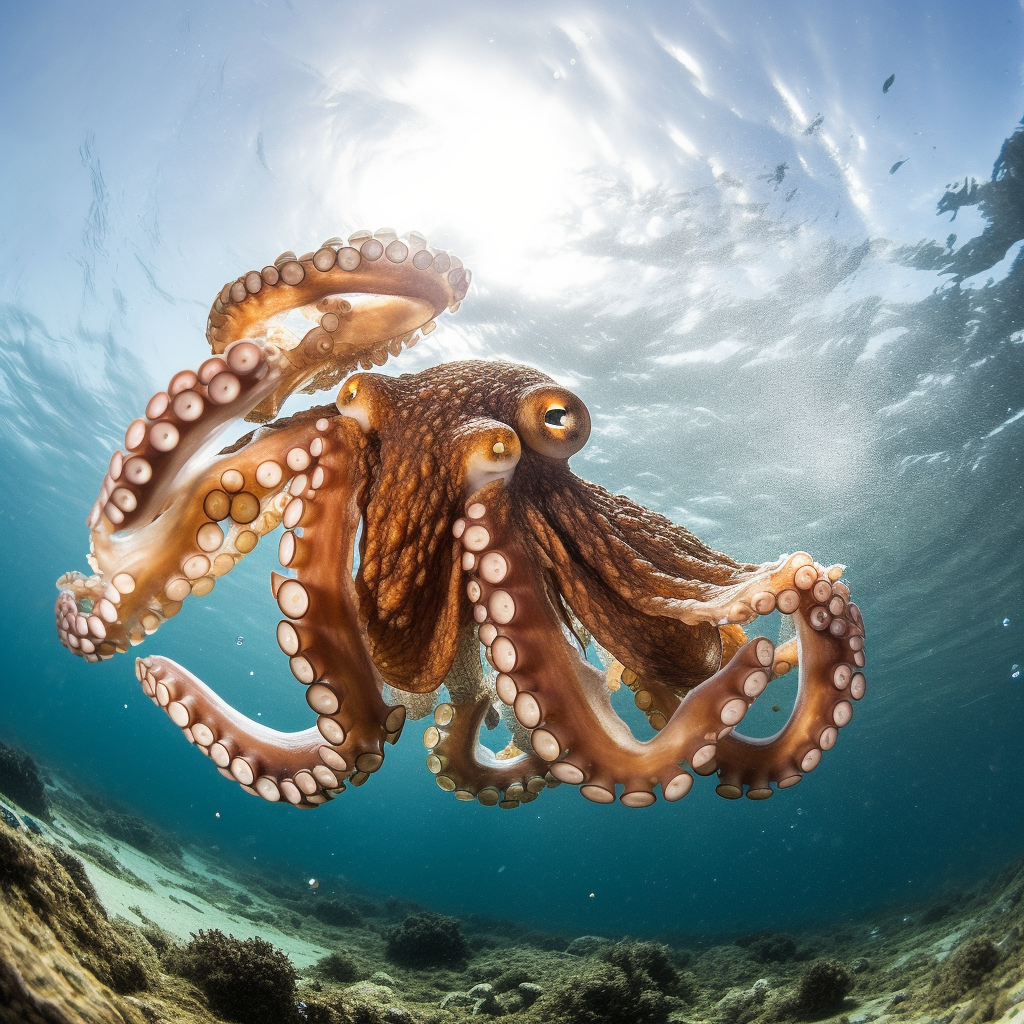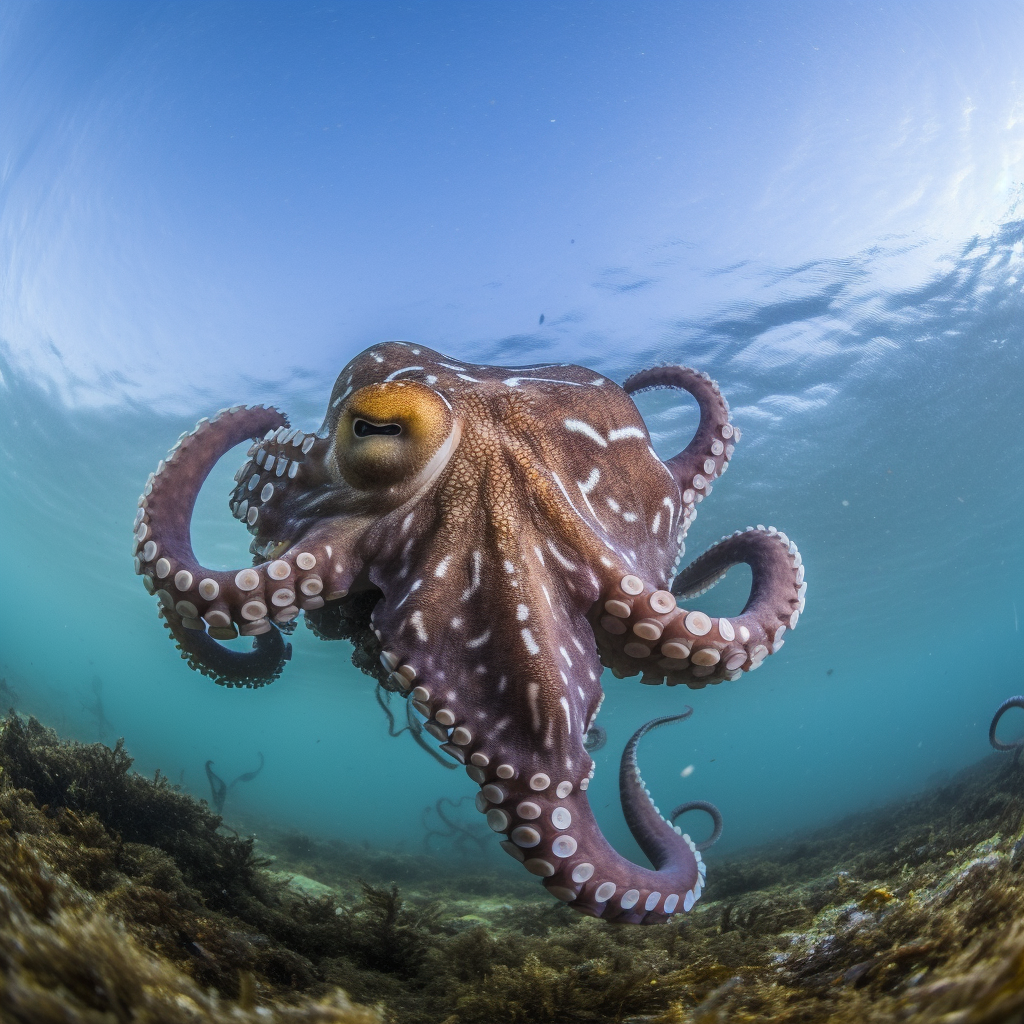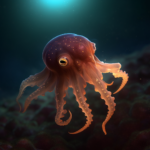Octopuses are fascinating creatures that inhabit the world‘s oceans, known for their remarkable intelligence and unique physical characteristics. One intriguing aspect of octopus behavior is their ability to swim. But just how fast can an octopus swim? In this article, we will explore the swimming capabilities of these cephalopods and delve into the factors that influence their speed. From their flexible bodies to their propulsion mechanisms, octopuses have evolved impressive swimming techniques that allow them to navigate the ocean with agility and grace. So, let’s dive in and discover the secrets of an octopus’s swimming prowess.
Key Takeaways
- Octopuses are incredibly agile swimmers and can reach speeds of up to 25 miles per hour.
- Their unique body structure and flexible arms allow them to move swiftly through the water.
- Octopuses primarily use jet propulsion to swim, expelling water from their mantle cavity to propel themselves forward.
- Their ability to change color and texture helps them camouflage and evade predators while swimming.
Understanding the Octopus: A Brief Overview
A. What Makes an Octopus Unique?
Octopuses are fascinating creatures that inhabit the depths of the ocean. These cephalopods belong to the class Cephalopoda, which also includes squids and cuttlefish. What sets octopuses apart from other marine animals is their remarkable ability to adapt and survive in their aquatic environment. Let’s explore some of the unique characteristics that make octopuses truly extraordinary.
-
Flexible and Agile Bodies: Octopuses have soft bodies that lack a rigid skeleton. Instead, they rely on a combination of muscles and a hydrostatic skeleton to move and change their shape. This flexibility allows them to squeeze through tight spaces and camouflage themselves against various backgrounds.
-
Incredible Camouflage: Octopuses possess an exceptional ability to change the color and texture of their skin, allowing them to blend seamlessly with their surroundings. They achieve this camouflage through specialized cells called chromatophores, which expand or contract to reveal different pigments. This camouflage helps them evade predators and sneak up on unsuspecting prey.
-
Intelligent and Curious: Octopuses are known for their high level of intelligence. They have a well-developed nervous system and complex brains, which enable them to solve puzzles, learn from their experiences, and exhibit problem-solving skills. They are also curious creatures, often exploring their surroundings and interacting with objects in their environment.
B. The Octopus: An Underwater Marvel
When it comes to underwater locomotion, octopuses employ a variety of techniques to move through the water with remarkable speed and agility. Their unique adaptations allow them to navigate their surroundings efficiently and even execute impressive escape tactics when faced with danger. Let’s delve into the fascinating world of octopus locomotion.
-
Jet Propulsion: One of the most notable methods of octopus propulsion is jet propulsion. By forcefully expelling water through a muscular funnel called a siphon, octopuses can propel themselves forward rapidly. This mechanism allows them to move swiftly and efficiently, making them formidable hunters and agile swimmers.
-
Arm Movement: Octopuses have eight arms lined with suckers that aid in their movement through the water. They can flex and extend their arms in various directions, providing them with exceptional maneuverability. By coordinating the movement of their arms, octopuses can achieve precise control and navigate complex underwater environments.
-
Coconut Carrying: While not directly related to swimming speed, it’s worth mentioning the coconut carrying behavior observed in some octopus species. In certain regions, octopuses have been observed collecting coconut shells and using them as portable shelters. They carry the shells with their arms and use them as protective coverings, showcasing their resourcefulness and adaptability.
Octopuses are incredible creatures that have mastered the art of underwater locomotion. Their ability to swim swiftly, change color and texture, and exhibit intelligent behavior make them truly remarkable. Understanding the unique characteristics and locomotion techniques of octopuses allows us to appreciate the wonders of the underwater world and the diversity of life within it.
The Speed of an Octopus: A General Perspective

A. Factors Affecting Octopus Speed
When it comes to the speed at which an octopus can swim, several factors come into play. The unique characteristics and abilities of these fascinating creatures contribute to their locomotion in water. Let’s explore some of the key factors that affect an octopus’s speed:
-
Body Shape and Size: Octopuses have a soft body with a streamlined shape, allowing them to move through water with relative ease. Their lack of a rigid skeleton enables them to squeeze through tight spaces and navigate complex underwater environments.
-
Muscular Structure: Octopuses possess a complex muscular system that allows them to control their movements with precision. Their arms, equipped with numerous suckers, provide both propulsion and maneuverability.
-
Jet Propulsion: One of the most remarkable features of an octopus is its ability to use jet propulsion. By rapidly expelling water through a funnel-like structure called a siphon, an octopus can generate a force that propels it forward. This mechanism allows for quick bursts of speed when needed.
-
Camouflage: Octopuses are masters of disguise, capable of changing the color and texture of their skin to blend seamlessly with their surroundings. This camouflage technique helps them evade predators and approach prey unnoticed. While camouflage doesn’t directly affect their speed, it plays a crucial role in their survival strategy.
B. Are Octopuses Fast Swimmers?
Octopuses may not be the fastest swimmers in the ocean, but they possess remarkable agility and adaptability in their underwater movements. Their speed varies depending on the species, environmental conditions, and the purpose of their locomotion.
-
Normal Swimming: During regular swimming, octopuses typically move at a leisurely pace, using a combination of arm movements and jet propulsion. This allows them to explore their surroundings and search for food without expending excessive energy.
-
Escape Tactics: When faced with a threat, such as a predator or disturbance, octopuses can employ rapid and erratic movements to evade capture. They may use their jet propulsion to quickly propel themselves away from danger, making it challenging for predators to catch them.
-
Hunting Strategies: Octopuses are skilled hunters, employing various techniques to capture their prey. Some species, like the mimic octopus, imitate other marine creatures to approach their victims stealthily. Others, like the blanket octopus, use their long, trailing arms to ensnare prey. These hunting strategies require a combination of speed, precision, and coordination.
-
Species Variations: Different species of octopuses exhibit varying swimming capabilities. For example, the common octopus (Octopus vulgaris) is known for its agility and speed, while the giant Pacific octopus (Enteroctopus dofleini) is larger and slower in comparison. The blue-ringed octopus (Hapalochlaena spp.) is relatively small but possesses venomous bites, relying on its toxic defense rather than speed.
In conclusion, while octopuses may not be the fastest swimmers in the ocean, they possess a range of adaptations and abilities that allow them to navigate their underwater world with remarkable skill. Their unique body structure, muscular control, jet propulsion, and camouflage techniques all contribute to their overall speed and agility. Whether they are leisurely exploring their surroundings or evading predators, octopuses are fascinating creatures to observe in their natural habitat.
The Speed of Different Octopus Species

Octopuses are fascinating creatures that inhabit the world‘s oceans, displaying a wide range of unique characteristics and behaviors. One aspect that sets them apart is their ability to swim. While not all octopus species are known for their swimming prowess, some can move through the water with surprising speed and agility. Let’s take a closer look at a few of these remarkable creatures and their swimming capabilities.
A. The Mimic Octopus: Master of Deception and Speed
The Mimic Octopus, scientifically known as Thaumoctopus mimicus, is renowned for its incredible ability to mimic other marine animals. This octopus species can imitate various creatures, including lionfish, sea snakes, and even flounders. However, its impressive mimicry skills are not limited to appearance alone. The Mimic Octopus is also a proficient swimmer.
With its eight flexible arms and a streamlined body, the Mimic Octopus can swiftly navigate through the water. While it may not be the fastest swimmer among octopuses, it can cover considerable distances with ease. This species uses a combination of jet propulsion and arm movements to propel itself forward, allowing it to swiftly escape predators or hunt for prey.
B. The Dumbo Octopus: Graceful and Swift
The Dumbo Octopus, named after the famous Disney character due to its ear-like fins, is another octopus species known for its swimming abilities. These deep-sea dwellers exhibit a graceful and almost ethereal movement as they glide through the water. Despite their small size, Dumbo Octopuses can reach impressive speeds.
Using their ear-like fins, Dumbo Octopuses gracefully flap and undulate, propelling themselves forward. This unique method of locomotion allows them to move swiftly and efficiently through the depths of the ocean. While their exact swimming speed is difficult to measure, they are undoubtedly one of the fastest swimmers among octopuses.
C. The Giant Pacific Octopus: Size and Speed Combined
As the largest species of octopus, the Giant Pacific Octopus (Enteroctopus dofleini) possesses an impressive combination of size and speed. These magnificent creatures can grow up to 16 feet in length and weigh over 100 pounds. Despite their bulk, they are surprisingly agile swimmers.
The Giant Pacific Octopus uses a combination of jet propulsion and arm movements to navigate through the water. By expelling water forcefully through a muscular funnel, they can propel themselves forward rapidly. Their large size allows for powerful movements, enabling them to cover significant distances in search of food or mates.
D. The Blue-Ringed Octopus: Small but Speedy
While the Blue-Ringed Octopus (genus Hapalochlaena) may be small in size, it is undoubtedly one of the fastest swimmers in the octopus world. These tiny creatures, measuring only a few inches in length, are known for their vibrant blue rings and potent venom. However, they are equally remarkable for their swimming capabilities.
The Blue-Ringed Octopus employs a unique mechanism known as “jet propulsion” to move through the water. By rapidly expelling water from their mantle cavity, they create a powerful jet that propels them forward. This propulsion method allows them to move swiftly and efficiently, making them highly effective hunters in their natural habitat.
In conclusion, while not all octopus species are known for their swimming abilities, some can move through the water with impressive speed and agility. The Mimic Octopus, Dumbo Octopus, Giant Pacific Octopus, and Blue-Ringed Octopus are just a few examples of octopuses that showcase remarkable swimming capabilities. Whether it’s through jet propulsion, arm movements, or a combination of both, these fascinating creatures have adapted unique techniques to navigate their watery homes.
The Mechanics of Octopus Swimming

A. How Does an Octopus Swim?
Octopuses are fascinating creatures that have evolved unique swimming techniques to navigate through water. Unlike fish, which use fins to propel themselves forward, octopuses rely on a combination of arm movements and jet propulsion to swim.
The primary method of propulsion for an octopus is through the expulsion of water. By rapidly contracting their muscular mantle, which surrounds their body, octopuses can expel water forcefully through a small opening called the siphon. This expulsion of water creates a backward thrust, propelling the octopus forward.
To control their movement, octopuses have a remarkable ability to change the direction of their siphon. By angling it in different directions, they can steer themselves through the water with precision. This flexibility allows them to navigate complex environments and even squeeze through narrow crevices.
B. The Role of Tentacles in Octopus Swimming
While the siphon provides the primary propulsion, the octopus’s eight arms, or tentacles, play a crucial role in its swimming abilities. Each arm is equipped with hundreds of suckers, which allow the octopus to grip onto surfaces and manipulate objects.
During swimming, the octopus extends its arms and undulates them in a wave-like motion. This movement creates a forward thrust, complementing the propulsion generated by the siphon. By coordinating the movements of its arms, the octopus can achieve efficient and agile swimming.
The arms also serve as a means of maneuvering and changing direction. By selectively extending and retracting specific arms, the octopus can alter its course or make quick turns. This flexibility is particularly useful when hunting prey or evading predators.
It’s worth noting that not all octopuses swim at the same speed. Different species have varying swimming capabilities, with some being faster than others. For example, the common octopus (Octopus vulgaris) is known to be a swift swimmer, while the larger giant Pacific octopus (Enteroctopus dofleini) tends to be slower but more powerful.
In conclusion, octopuses have developed unique swimming techniques that rely on a combination of jet propulsion and arm movements. Their ability to expel water through their siphon and manipulate their arms allows them to navigate through water with agility and precision. The specific swimming speed of an octopus depends on its species, with some being faster than others. Overall, these fascinating creatures showcase remarkable underwater locomotion capabilities.
The Distance an Octopus Can Swim
Octopuses are fascinating creatures that inhabit the world‘s oceans, known for their intelligence and unique abilities. One of the questions that often arises is how far can an octopus swim? Let’s explore the distance an octopus can cover and the stamina of different octopus species.
A. How Far Can a Giant Octopus Swim?
The giant octopus, also known as the North Pacific giant octopus (Enteroctopus dofleini), is the largest species of octopus in the world. These incredible creatures can grow up to 16 feet in length and weigh over 100 pounds. With their size and strength, it’s no wonder that they are capable of covering impressive distances.
While there isn’t a definitive answer to how far a giant octopus can swim, researchers have observed these creatures traveling long distances in search of food or mates. They have been known to migrate across vast stretches of the ocean floor, traversing up to hundreds of miles in their lifetime.
Giant octopuses have a unique mode of locomotion that allows them to move swiftly through the water. They use their muscular arms to push off the ocean floor, propelling themselves forward. This movement, combined with their ability to change the color and texture of their skin, allows them to blend seamlessly into their surroundings, making them efficient hunters and elusive prey.
B. The Stamina of Different Octopus Species
While the giant octopus is known for its impressive size and strength, other octopus species also exhibit remarkable swimming capabilities. Each species has its own unique adaptations and swimming techniques that enable them to navigate their aquatic environment.
One such example is the common octopus (Octopus vulgaris), a species found in the Mediterranean Sea and the Atlantic Ocean. These octopuses have been observed swimming at speeds of up to 25 miles per hour, using a combination of jet propulsion and arm movements. They can expel water forcefully through a funnel-like structure called a siphon, allowing them to move rapidly in short bursts.
Another species worth mentioning is the mimic octopus (Thaumoctopus mimicus), known for its ability to imitate other marine creatures. This octopus can change its shape, color, and movement patterns to mimic various animals, such as lionfish, sea snakes, and flatfish. While their swimming speed may not be as fast as some other species, their unique camouflage abilities make them masters of deception and evasion.
It’s important to note that the swimming capabilities of octopuses can vary depending on factors such as size, habitat, and species-specific adaptations. Some octopuses may be better suited for short bursts of speed, while others may excel in endurance swimming.
In conclusion, octopuses are fascinating creatures with impressive swimming abilities. From the giant octopus‘s long-distance migrations to the common octopus’s jet propulsion and the mimic octopus’s camouflage skills, each species showcases unique adaptations for underwater locomotion. While the exact distance an octopus can swim may vary, these creatures continue to captivate researchers and enthusiasts alike with their remarkable abilities in the vast world beneath the waves. Conclusion
In conclusion, octopuses are incredibly fascinating creatures with remarkable swimming abilities. Despite lacking a streamlined body shape like fish, they are capable of propelling themselves through the water using their muscular arms and siphon. While their exact swimming speed can vary depending on the species and individual, octopuses have been observed reaching speeds of up to 25 miles per hour (40 kilometers per hour). This impressive speed allows them to swiftly navigate their marine environment and escape from predators or catch prey. The unique combination of their flexible bodies, jet propulsion, and intelligent navigation skills make octopuses one of the most agile and efficient swimmers in the ocean. Understanding the swimming capabilities of these cephalopods not only sheds light on their evolutionary adaptations but also highlights their incredible versatility in the underwater world. So, the next time you come across an octopus, remember that beneath their seemingly slow and graceful movements lies a hidden speed demon capable of darting through the water with astonishing agility.
Frequently Asked Questions
How fast can a mimic octopus swim?
The mimic octopus, known for its ability to imitate other marine animals, can reach speeds of up to 2.5 mph when using its jet propulsion for escape or hunting.
How fast can a dumbo octopus swim?
The dumbo octopus, named for its ear-like fins, isn’t a particularly fast swimmer. It tends to hover and glide more than swim, reaching speeds of about 0.5 mph.
Do octopuses swim fast?
Octopuses are not known for their speed, but rather their agility and ability to squeeze into tight spaces. However, some species like the mimic octopus can reach speeds up to 2.5 mph.
How fast does an octopus swim?
The speed of an octopus can vary greatly depending on the species. On average, they can swim at speeds between 0.5 to 2.5 mph.
How fast can a giant pacific octopus swim?
The giant pacific octopus, one of the largest species of octopus, can reach speeds of up to 2.5 mph when using its jet propulsion.
How fast can an octopus swim?
On average, octopuses can swim at speeds between 0.5 to 2.5 mph. However, this can vary greatly depending on the species and the situation.
How fast can a giant octopus swim?
A giant octopus, such as the giant pacific octopus, can reach speeds of up to 2.5 mph when using its jet propulsion.
How fast can a blue ringed octopus swim?
The blue ringed octopus, known for its deadly venom, is not a particularly fast swimmer. It tends to crawl along the seafloor more than swim, but can reach speeds of about 1 mph when necessary.
Are octopuses fast swimmers?
While octopuses are not the fastest swimmers in the ocean, they are capable of short bursts of speed when necessary. On average, they can swim at speeds between 0.5 to 2.5 mph.
How far can an octopus swim?
Octopuses are not known for long-distance swimming. They tend to stay within a home range, moving around to hunt or escape predators. However, some species have been known to travel several miles in search of food or mates.




